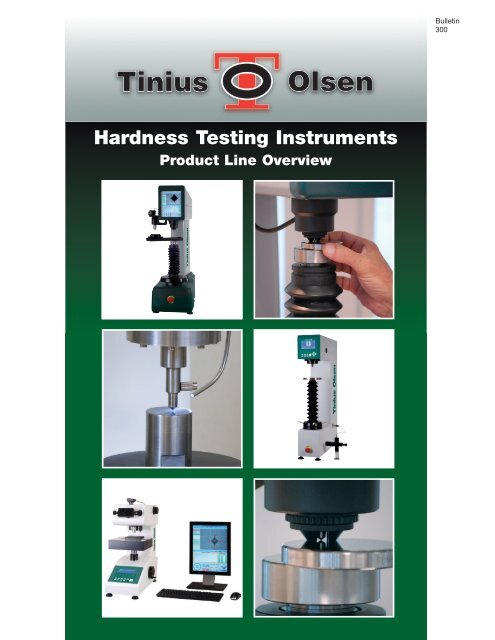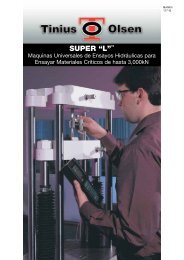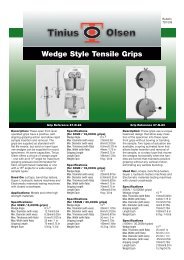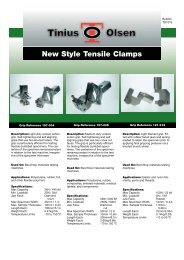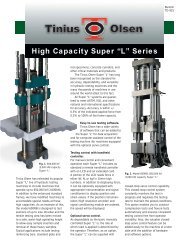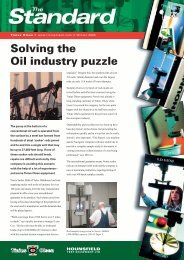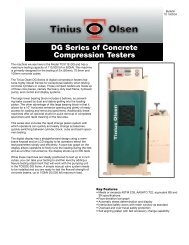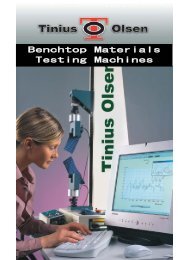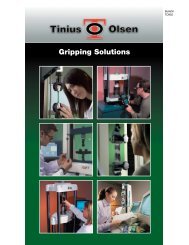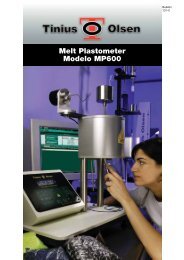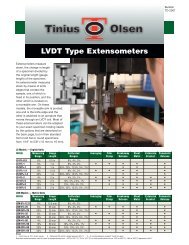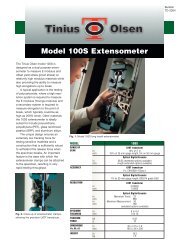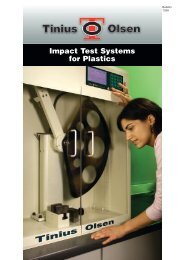Bulletin 300 Hardness Testing Instruments Product ... - Tinius Olsen
Bulletin 300 Hardness Testing Instruments Product ... - Tinius Olsen
Bulletin 300 Hardness Testing Instruments Product ... - Tinius Olsen
Create successful ePaper yourself
Turn your PDF publications into a flip-book with our unique Google optimized e-Paper software.
<strong>Hardness</strong> <strong>Hardness</strong> <strong>Testing</strong> <strong>Testing</strong> <strong>Instruments</strong><br />
<strong>Instruments</strong><br />
<strong>Hardness</strong> <strong>Testing</strong> <strong>Instruments</strong><br />
<strong>Product</strong> <strong>Product</strong> Line Line Overview<br />
Overview<br />
<strong>Product</strong> Line Overview<br />
<strong>Bulletin</strong><br />
<strong>300</strong>
2<br />
<strong>Hardness</strong> Tester Series Overview<br />
Basic,<br />
load cell<br />
based<br />
Rockwell<br />
tester<br />
FH30 Series FH1 Series FH2 Series FH10 Series<br />
Rockwell <strong>Hardness</strong> Testers<br />
FH1 Series FH2 Series FH4 Series<br />
Vickers <strong>Hardness</strong> Testers<br />
FH1 Series FH2 Series FH9 Series FH10 Series<br />
Brinell <strong>Hardness</strong> Testers<br />
FH1 Series FH2 Series FH10 Series FH12 Series<br />
Universal <strong>Hardness</strong> Testers<br />
FH12 Series<br />
FH5 Series FH9 Series FH10 Series<br />
FH12 Series<br />
FH12 Series
HARDNESS<br />
<strong>Hardness</strong> is the property of a material enabling it to resist plastic<br />
deformation, usually by penetration of another object. The term<br />
“hardness” may also refer to stiffness, temper or resistance to<br />
bending, scratching, abrasion or cutting.<br />
Scientists and journalists often confuse stiffness with hardness<br />
and is demonstrated by, for example, the element Osmium which<br />
is stiffer than diamond, but not as hard as diamond.<br />
In materials science there are three principal operational<br />
definitions of hardness:<br />
Scratch hardness: Resistance to fracture or plastic (permanent)<br />
deformation due to friction from a sharp object<br />
Indentation hardness: Resistance to plastic (permanent)<br />
deformation due to a constant load from a sharp object<br />
Rebound hardness: Height or speed of the bounce of an object<br />
dropped on the material, related to elasticity.<br />
MEASURING HARDNESS<br />
<strong>Hardness</strong> is not an intrinsic material property. There are no precise<br />
definitions in terms of fundamental units of mass, length, and<br />
time. A hardness property value is the result of a defined<br />
measurement procedure.<br />
<strong>Hardness</strong> of materials has probably long been assessed by<br />
resistance to scratching or cutting. An example would be material<br />
B scratches material C, but not material A. Alternatively, material A<br />
scratches material B slightly and scratches material C heavily.<br />
The usual method to obtain a hardness value is to measure the<br />
depth or area of an indentation left by an indentor of a specific<br />
shape, with a specific force applied for a specific time. There<br />
are several principal standard test methods to express the<br />
relationship between hardness and the size of the impression<br />
or the rebound velocity on specific materials. Vickers, Rockwell,<br />
Brinell, and Leeb are the most common scales. For practical and<br />
calibration reasons, each of these methods is divided into a range<br />
of scales, defined by a combination of applied load and indentor<br />
geometry or in case of the rebound method, by the weight of the<br />
impact body.<br />
MOST COMMON HARDNESS TESTS<br />
Rockwell (HR scales)<br />
Indenting the test material with a diamond cone (HRC) or<br />
hardened (tungsten) steel ball indentor (HRB etc.) applying a<br />
preload of 10kgf first and a main test force of 60, 100, or 150kgf.<br />
Rockwell Superficial (HR scales)<br />
Indenting the test material with a diamond cone or hardened<br />
(tungsten) steel ball indentor, depending on the scale preliminary<br />
set. The Superficial Rockwell scales use lower force and<br />
shallower impressions on brittle and very thin materials. Applying<br />
a preload of 3kgf first and a main test force of 15, 30, or 45kgf.<br />
Vickers (HV)<br />
Indenting the test material with a diamond indentor, in the form of<br />
an upside down perfect pyramid with a square base and an angle<br />
of 136 degrees between opposite faces, subjected to test forces<br />
of 1 to 120kgf. A microscope or USB camera is used to visualize<br />
and measure the indentation.<br />
Micro-Vickers (HV)<br />
Indenting the test material with a diamond indentor, in the form<br />
of an upside down perfect pyramid with a square base and an<br />
angle of 136 degrees between opposite faces, subjected to test<br />
forces usually not exceeding 1kgf. A precision microscope or<br />
high resolution USB camera is used to visualize and measure the<br />
indentations, magnifications up to 600x are most common. However,<br />
magnifications up to 1000x are becoming popular as well.<br />
Knoop (HK)<br />
Indenting the test material with an “elongated” diamond pyramid,<br />
subjected to test forces usually not exceeding 1kgf. A precision<br />
microscope or high resolution USB camera is used to visualize<br />
and measure the indentations, magnifications up to 600x are most<br />
common.<br />
Brinell (HB)<br />
Indenting the to be tested material with a 1, 2.5, 5, or 10mm<br />
diameter hardened steel or carbide ball subjected to a load/force<br />
ranging from 1 to <strong>300</strong>0kg. A microscope or USB camera is used<br />
to visualize and measure the rather large indentations.<br />
Leeb (HL) (rebound method)<br />
Portable hardness testing. An impact body, which has a spherical<br />
tungsten carbide tip, is impelled onto the test surface by spring<br />
force. The impact creates a plastic deformation of the surface, an<br />
indentation, due to which the impact body loses part of its original<br />
speed (or energy). Consequently, the softer the material is, the<br />
more speed will be lost at rebound of the impact body. Applicable<br />
for a wide variety of components, minimum test requirements<br />
should be obeyed.<br />
Ultrasonic (UCI)<br />
Portable hardness testing. A Vickers shaped diamond indentor<br />
fixed on a vibrating rod that presses on the test surface with<br />
a specific force and then measures its hardness by applying<br />
ultrasonic vibrations and analyzing its damping effect. Commonly<br />
used for small, thin components that cannot be tested by rebound<br />
hardness testers.<br />
Shore (HS scales)<br />
Portable (rubber/plastics) hardness testing. The hardness value is<br />
determined by pressing the indentor foot firmly onto the sample.<br />
The indentor is connected to a linear measuring device and<br />
measures the indent depth, which is then converted through a<br />
mechanical or an electronical system to the Shore value. The<br />
deeper the indent, the softer the material.<br />
IRHD<br />
Measures the indentation resistance of elastomeric or rubber<br />
materials based on the depth of penetration of a ball indentor. An<br />
initial contact force is applied to a 1, 2.5, or 5mm ball indentor and<br />
the penetration is set to zero. The force is increased to a specified<br />
total load and the depth of the penetration is measured. The IRHD<br />
value is related to the depth of indentor penetration. The method<br />
is commonly used for testing small parts and O-rings.<br />
Webster<br />
Portable hardness testing. The object to be tested is placed<br />
between the anvil and the penetrator. Pressure is then applied to<br />
the handles until "bottom" is felt, at which time the dial indicator<br />
is read. There are different types of indentors and different force<br />
settings for different materials.<br />
Less common hardness scales<br />
The following hardness methods are less frequently used or<br />
superseded by other methods:<br />
HM - Martens (formerly HU – universal hardness)<br />
H - ball indentation hardness<br />
HVT - modified Vickers method, depth measurement<br />
HBT - modified Brinell method, depth measurement<br />
3
4<br />
FH-1 Series Rockwell And Universal <strong>Hardness</strong> Testers<br />
Fig 1. Model FH-1-1<br />
Fig 2a. Model FH-1-3<br />
from side<br />
Fig 2. Model FH-1-3<br />
Model FH-1-1<br />
Rockwell and Superficial Rockwell<br />
Scales:<br />
Rockwell-A, B, C, D, E, F, G, H, K, L, M, P, R, S, V<br />
Superficial Rockwell: 15N, 30N, 45N, 15T, 30T, 45T,<br />
15W, 30W, 45W, 15X, 30X, 45X, 15Y, 30Y, 45Y<br />
Model FH-1-2<br />
Rockwell, Superficial Rockwell, and Brinell<br />
Same as FH-1-1, but with additional<br />
Brinell scales<br />
<br />
Brinell: HB1/1, 2.5, 5, 10, 30kgf; HB2.5/6.25,<br />
15.625, 31.25, 62.5, 87.5kgf; HB5/ 25, 62.5, 125,<br />
250kgf; HB10/ 100, 250kgf<br />
<br />
Model FH-1-3<br />
Rockwell, Superficial Rockwell, Brinell, Vickers,<br />
HBT and HVT<br />
Same as FH-1-2, but with additional<br />
Vickers scales<br />
Scales<br />
Brinell: HBT2.5/62.5, 187.5kgf; HBT5/250kgf;<br />
Vickers: HV 1, 2, 3, 5, 10, 20, 30, 50, 100, 120;<br />
HVT 50, 100kgf<br />
<br />
Vickers indent measurement<br />
<br />
<br />
<br />
<br />
<br />
Optional Accessories For<br />
FH 1 Series<br />
<br />
Motorized elevator spindle<br />
<br />
<br />
<br />
<br />
<br />
with T-slot
FH-2 Series Rockwell And Universal <strong>Hardness</strong> Testers<br />
Fig 3. Model FH-2-0<br />
Fig 4. Model FH-2-1<br />
Fig 4a. Model FH-2-1 from side<br />
Model FH-2-0<br />
Rockwell, Superficial Rockwell, HBT, HVT, and<br />
H ball indentation<br />
ouch screen controller<br />
<br />
<br />
Scales:<br />
Rockwell - A, B, C, D, E, F, G, H, K, L, M, P, R, S, V,<br />
Superficial Rockwell -15N, 30N, 45N, 15T, 30T,<br />
45T, 15W, 30W, 45W, 15X, 30X, 45X, 15Y, 30Y, 45Y<br />
Brinell - HBT2.5/62.5, 187.5kgf; HBT5/250kgf<br />
Vickers - HVT 50, 100kgf<br />
<br />
<br />
<br />
<br />
<br />
<br />
<br />
<br />
Model FH-2-1<br />
Brinell, Vickers, Knoop, HBT, and HVT<br />
Same as FH-2-0 but with the following<br />
additional features:<br />
CCD USB Video system, manual & automatic<br />
measurement of Brinell and Vickers/Knoop<br />
indentations, indent Video zoom function<br />
Scales;<br />
Brinell - HB1/1, 2.5, 5, 10, 30kgf;<br />
HB2.5/6.25, 15.625, 31.25, 62.5, 187.5kgf; HB5/ 25,<br />
62.5, 125, 250kgf; HB10/ 100, 250kgf; HBT2.5/62.5,<br />
187.5kgf; HBT5/250kgf;<br />
Vickers - HV 1, 2, 3, 5, 10, 20, 30, 50, 100, 120;<br />
<br />
Vickers indent measurement<br />
<br />
<br />
<br />
Optional Accessories For<br />
FH 2 Series<br />
<br />
<br />
<br />
<br />
<br />
<br />
<br />
with T-slot<br />
<br />
<br />
LED ringlight<br />
5
6<br />
Rockwell <strong>Hardness</strong> Explained<br />
The Rockwell <strong>Hardness</strong> test is a hardness measurement<br />
based on the net increase in depth of impression when<br />
a load is applied. <strong>Hardness</strong> values are commonly given<br />
in the A, B, C, R, L, M, E and K scales. The higher the<br />
value in each of the scales, the harder the material.<br />
<strong>Hardness</strong> has been variously defined as resistance to<br />
local penetration, scratching, machining, wear or<br />
abrasion. In the Rockwell method of hardness testing,<br />
the depth of penetration of an indentor under certain<br />
arbitrary test conditions is determined. The indentor<br />
may either be a steel (carbide) ball of some specified<br />
diameter or a spherical diamond-tipped cone of 118°<br />
angle and 0.2mm tip radius also called indentor.<br />
The type of indentor and the test load determine the<br />
hardness scale (A, B, C, etc.)<br />
A minor load of 3kg or 10kg is first applied, causing an<br />
initial penetration and holding the indentor in place.<br />
Then, the dial is set to zero and the major load is<br />
applied. Upon removal of the major load, the depth<br />
reading is taken while the minor load is still on.<br />
The hardness number may then be read directly from<br />
the scale.<br />
The Rockwell scale characterizes the indentation<br />
hardness of materials through the depth of penetration<br />
of an indentor, loaded on a material sample and compared<br />
to the penetration in some reference material.<br />
It is one of several definitions of hardness in materials<br />
science. Its hardness values are noted by HR’X’ is the<br />
letter for the scale used. <strong>Hardness</strong> relation to strength<br />
is that both are measures of the pressure it takes to get<br />
plastic deformation to occur in materials.<br />
The Rockwell hardness test was devised by metallurgist<br />
Stanley P. Rockwell in Syracuse, NY, around 1919, in<br />
order to quickly determine the effects of heat treatment<br />
on steel bearing races. The Brinell hardness test,<br />
invented in 1900 in Sweden, was slow, not useful on<br />
fully hardened steel, and left too large impressions to<br />
be considered non-destructive. Rockwell collaborated<br />
with an instrument manufacturer to commercialize his<br />
invention and develop standardized testing machines.<br />
OPERATION<br />
The determination of the Rockwell hardness of a<br />
material involves the application of a minor load<br />
followed by a major load, and then noting the depth<br />
of penetration, converted to a hardness value directly<br />
from a dial or display, in which a harder material gives<br />
a higher number. The major advantage of Rockwell<br />
hardness is its ability to display hardness values directly,<br />
thus obviating tedious calculations involved in other<br />
hardness measurement techniques. Also, the relatively<br />
simple and inexpensive set-up enables installation<br />
under various conditions.<br />
Rockwell testers are typically used in engineering,<br />
metallurgy, and industrial environments. The commercial<br />
popularity arises from its speed, reliability, robustness,<br />
resolution and small area of indentation.<br />
GOOD PRACTICES<br />
Cleaning indentor and test-piece to be clear of dirt,<br />
grease, rust, or paint. Measuring on a perpendicular,<br />
flat surface (round work correction factors are invoked<br />
to adjust for test-piece curvature). Ensuring that the<br />
thickness of the test-piece is at least 10 times the depth<br />
of the indentation. Maintaining an adequate spacing<br />
between multiple indentations. Controlling the speed of<br />
indentation and assuring that the load duration (dwell)<br />
time is applied correctly.<br />
SCALES AND VALUES<br />
The most common used are the “B”, and “C” scales.<br />
Both express hardness as an arbitrary dimensionless<br />
number.<br />
The B-scale is used for softer materials (such as<br />
aluminum, brass, and softer steels). It employs a<br />
tungsten carbide ball as the indentor and a 100-kg<br />
weight to obtain a value expressed as “HRB”.<br />
The C-scale, for harder materials, uses a diamond cone<br />
and a 150-kg weight to obtain a value expressed as<br />
“HRC”. There are several alternative scales for other<br />
purposes.<br />
The superficial Rockwell scales use lower loads<br />
and shallower impressions on brittle and very thin<br />
materials. The 45N scale employs a 45-kg load on a<br />
diamond cone-shaped Brale indentor, and can be used<br />
on dense ceramics. The 15T scale employs a 15-kg load<br />
on a 1/16- inch diameter hardened steel ball, and can<br />
be used on sheet metal. Readings below HRC 20 are<br />
generally considered unreliable, as are readings much<br />
above HRB 100.<br />
TYPICAL VALUES<br />
Very hard steel (e.g. a good knife blade): HRC 55 - HRC<br />
62; Axes, chisels, etc.: HRC 40 - 45<br />
Several other scales, including the extensive A-scale,<br />
are used for specialized applications. There are special<br />
scales for measuring case-hardened specimens.
FH-4 Series Micro-Vickers <strong>Hardness</strong> Testers<br />
Analog<br />
Fig 6. Model FH-4-0<br />
Fig 7. Model FH-4, Shown with<br />
optional motorized x-y stage<br />
Model FH-4-0<br />
Digital microscope, 2kgf test force<br />
Micro-Vickers and Knoop<br />
<br />
<br />
<br />
<br />
on-line statistics, memory overview, tester settings<br />
<br />
<br />
<br />
Model FH-4-1<br />
Digital microscope, 2kgf test force<br />
Micro-Vickers and Knoop<br />
<br />
3 objectives<br />
Supplied as Standard with:<br />
<br />
<br />
<br />
<br />
<br />
<br />
<br />
<br />
<br />
<br />
<br />
Optional Accessories<br />
<br />
<br />
systems<br />
<br />
<br />
<br />
<br />
<br />
Digital Motorized, small Motorized, large<br />
7
8<br />
FH-5 Series Vickers <strong>Hardness</strong> Testers<br />
Fig 8. Model FH-5-0<br />
Fig 9. Model FH-5-3<br />
shown with small motorized<br />
table and Horizon Vision<br />
measuring and filing system<br />
FH-5 Series<br />
Micro-Vickers, Vickers, Knoop and low force Brinell<br />
<br />
<br />
<br />
<br />
Tensile Strength<br />
<br />
<br />
statistics, memory overview, tester settings<br />
Model FH-5-0<br />
Vickers and Knoop<br />
Test loads of: 1, 2, 2.5, 3, 4, 5, 10, 20, 30 kgf<br />
Model FH-5-1<br />
Vickers and Brinell (low force with 1 and 2mm ball)<br />
1, 2, 2.5, 3, 4, 5, 6.25, 10, 15.625, 20,<br />
31.25 kgf<br />
Model FH-5-2<br />
Micro / Macro Vickers and Knoop<br />
0.3, 0.5, 1, 2, 2.5, 3, 4, 5, 10, 20,<br />
30 kgf<br />
Model FH-5-3<br />
Micro / Macro Vickers and Knoop<br />
0.02, 0.025, 0.05, 0.1, 0.2, 0.3, 0.5, 1,<br />
2, 2.5, 3, 4, 5, 10, 20, 30kgf<br />
Model FH-5-4<br />
Micro / Macro Vickers, Knoop and Brinell<br />
s FH-5-3 plus: 6.25, 15.625,<br />
31.25 kgf<br />
Model FH-5-5<br />
Macro Vickers and Knoop<br />
<br />
Model FH-5-6<br />
Vickers and Brinell (low force with 1,2 and<br />
5mm ball)<br />
<br />
31.25, 62.5 kgf<br />
Model FH-5-7<br />
Micro / Macro Vickers and Knoop<br />
<br />
50 kgf<br />
Model FH-5-8<br />
Micro / Macro Vickers and Knoop<br />
<br />
20, 30, 50 kgf<br />
Model FH-5-9<br />
Micro / Macro Vickers, Knoop and Brinell<br />
FH-5-8 plus: 6.25, 15.625, 31.25,<br />
62.5,kgf<br />
Supplied As Standard With:<br />
<br />
<br />
<br />
<br />
<br />
<br />
<br />
<br />
<br />
<br />
<br />
<br />
Optional Accessories
Vickers <strong>Hardness</strong> and Brinell <strong>Hardness</strong> Explained<br />
VICKERS HARDNESS TEST<br />
The Vickers hardness test was developed in 1924 by Smith and<br />
Sandland at Vickers Ltd as an alternative to the Brinell method to<br />
measure the hardness of materials.<br />
The Vickers test is often easier to use than other hardness tests,<br />
since the required calculations are independent of the size of<br />
the indentor, and the indentor can be used for all materials<br />
irrespective of hardness.<br />
The basic principle, as with all common measures of<br />
hardness, is to observe the questioned material’s ability to resist<br />
plastic deformation from a standard source.<br />
The Vickers test<br />
can be used for<br />
all metals and<br />
has one of the<br />
widest scales<br />
among hardness<br />
tests. The<br />
unit of hardness<br />
given by the<br />
test is known<br />
as the Vickers<br />
Pyramid Number (HV) or Diamond Pyramid <strong>Hardness</strong> (DPH).<br />
The hardness number can be converted into units of Pascals, but<br />
should not be confused with a pressure, which also has units of<br />
Pascals. The hardness number is determined by the load over<br />
the surface area of the indentation and not the area normal to the<br />
force, and is therefore not a pressure.<br />
The hardness number is not really a true property of the material<br />
and is an empirical value that should be seen in conjunction with<br />
the experimental methods and hardness scale used.<br />
When doing the hardness tests the distance between indentations<br />
must be more than 2.5 indentation diameters apart to avoid<br />
interaction between the work-hardened regions.<br />
Implementation<br />
An indentation left in case-hardened steel after a Vickers hardness<br />
test. It was decided that the indentor shape should be capable of<br />
producing geometrically similar impressions, irrespective of size;<br />
the impression should have well defined points of measurement;<br />
and the indentor should have high resistance to self-deformation.<br />
A diamond in the form of a square-based pyramid satisfied these<br />
conditions.<br />
It had been established that the ideal size of a Brinell impression<br />
was 3/8 of the ball diameter. As two tangents to the circle at the<br />
ends of a chord 3d/8 long intersect at 136°, it was decided to<br />
use this as the included angle of the indentor. The angle was<br />
varied experimentally and it was found that the hardness value<br />
obtained on a homogeneous piece of material remained constant,<br />
irrespective of load. Accordingly, loads of various magnitudes<br />
are applied to a flat surface, depending on the hardness of the<br />
material to be measured.<br />
The HV number is then determined by the ratio F/A where F is<br />
the force applied to the diamond in kilograms-force and A is the<br />
surface area of the resulting indentation in square millimetres. A<br />
can be determined by the formula which can be approximated by<br />
evaluating the sine term to give where d is the average length of<br />
the diagonal left by the indentor.<br />
Vickers hardness numbers are reported as xxxHVyy, e.g.<br />
440HV30, or xxxHVyy/zz if duration of force differs from 10s to<br />
15s, e.g. 440Hv30/20, where: 440 is the hardness number,<br />
HV gives the hardness scale (Vickers),<br />
30 indicates the load used in kg.<br />
20 indicates the loading time if it differs from 10s to 15s<br />
Vickers values are generally independent of the test force, they<br />
will come out the same for 500gf and 50kgf, as long as the force<br />
is at least 200gf.<br />
Examples of HV values for various materials<br />
Material Value<br />
316L stainless steel 140HV30<br />
347L stainless steel 180HV30<br />
Carbon steel 55–120HV5<br />
Iron 30–80HV5<br />
BRINELL HARDNESS TEST<br />
The Brinell scale characterizes the indentation hardness of<br />
materials through the scale of penetration of an indentor,<br />
loaded on a material test-piece. Proposed by Swedish engineer<br />
Johan August Brinell in 1900, it was the first widely used and<br />
standardized hardness test in engineering and metallurgy.<br />
The typical tests use a 10, 5, 2.5 or 1mm diameter steel ball as an<br />
indentor with a test force starting at 1kgf up to 3,000kgf (29 kN)<br />
force. For softer materials, a lower force is used; for harder<br />
materials, a tungsten carbide ball is substituted for the steel ball.<br />
After the impression is<br />
made, a measurement<br />
of the diameter of the<br />
resulting round<br />
impression (d) is taken.<br />
It is measured to plus<br />
or minus 0.05mm using<br />
a low-magnification<br />
microscope. The<br />
hardness is calculated<br />
by dividing the load<br />
by the area of the<br />
curved surface of the<br />
indentation, (the area of a<br />
hemispherical surface is<br />
arrived at by multiplying<br />
the square of the<br />
diameter by 3.14159<br />
and then dividing by 2).<br />
Common values<br />
The standard format for specifying tests can be seen in the<br />
example “HBW 10/<strong>300</strong>0”. “HBW” means that a tungsten carbide<br />
(from the chemical symbol for tungsten) ball indentor was used,<br />
as opposed to “HBS”, which means a hardened steel ball. The<br />
“10” is the ball diameter in millimeters. The “<strong>300</strong>0” is the force in<br />
kilograms force.<br />
Standards<br />
<br />
<br />
9
10<br />
FH9 Series Brinell <strong>Hardness</strong> Testers<br />
Fig 10. Model FH-9-1<br />
Fig 11. Model FH-9-20<br />
Model FH-9-0<br />
Brinell and Vickers<br />
<br />
<br />
<br />
statistics and tester settings<br />
<br />
Brinell and Leeb<br />
<br />
indentation measurement or, optionally, external<br />
ELECTRONIC digital microscope for automatic<br />
indentation measurement<br />
Model FH-9-1<br />
Brinell<br />
<br />
450mm workpiece height, 250mm throat depth<br />
Model FH-9-17<br />
Brinell<br />
<br />
Model FH-9-2<br />
Brinell and Vickers<br />
<br />
supplied with three objectives<br />
Model FH-9-3<br />
Brinell and Vickers<br />
<br />
450mm workpiece height, 250mm throat depth<br />
Model FH-9-3<br />
Brinell and Vickers<br />
<br />
450mm workpiece height, 250mm throat depth<br />
Model FH-9-4<br />
Brinell and Vickers<br />
<br />
Model FH-9-20<br />
Brinell<br />
<br />
auto focus - hence fully automatic.<br />
<br />
Supplied As Standard With:<br />
<br />
series)<br />
<br />
<br />
<br />
<br />
<br />
<br />
<br />
Optional Accessories<br />
<br />
magnification (digital series) for automatic<br />
measurement<br />
<br />
<br />
models<br />
<br />
9.8”)
FH10 Series Universal <strong>Hardness</strong> Testers<br />
Fig 12. <br />
Fig 13. <br />
Model FH-10-0<br />
Rockwell, Superficial Rockwell, Brinell,<br />
Vickers and HVT, HBT<br />
<br />
<br />
<br />
<br />
<br />
<br />
<br />
<br />
<br />
<br />
<br />
<br />
<br />
<br />
<br />
Supplied As Standard With:<br />
<br />
<br />
<br />
<br />
<br />
<br />
<br />
Optional Accessories
12<br />
FH12 Series Universal <strong>Hardness</strong> Testers<br />
FIG 15. Model FH-12-0<br />
Model FH-12 series heavy duty<br />
Brinell, Vickers, Rockwell, HVT and HBT<br />
FH-12 a universal hardness tester most suitable for<br />
heavy duty testing. Built for tough environments and<br />
extra large workspace accomodation.<br />
Suitable for parts up to 500kgf. The floor type frame<br />
reaches a height of 2 meters and offers a workspace<br />
of not less than 650mm height and a throat depth of<br />
<strong>300</strong>mm. Rockwell, Vickers and Brinell, but also pure<br />
depth test methods such as H-ball, HVT and HBT are<br />
part of the standard test procedures of the FH-12. 3<br />
models cover a range of test loads either up to 250,<br />
750kgf or <strong>300</strong>0kgf.<br />
The FH-12 has a motorized elevetor spindle and a<br />
descending test head, allowing each test piece to be<br />
tested on an ergonomic working height. The test head<br />
is equipped with a 6 positions modular turret (indentors<br />
and objectives) and an optical zoom video system with<br />
5mp HD camera.<br />
High performance PC driven automatic and manual<br />
indent measurement with automatic filing and storage<br />
functions.<br />
Refined algorithms for automatic measurement<br />
on materials normally less suitable for automatic<br />
measurement.<br />
Model FH-12-0<br />
<br />
Model FH-12-1<br />
.<br />
Model FH-12-2<br />
<br />
Supplied As Standard With:<br />
<br />
<br />
<br />
<br />
<br />
<br />
<br />
<br />
Optional Accessories
Horizon <strong>Hardness</strong> Software<br />
Screen 1. Results from a five<br />
location hardness test showing the<br />
mean and standard deviation of the<br />
results Screen 2. showing the user defined<br />
pattern/sequence of hardness<br />
measurement locations<br />
Screen 4. showing the filar lines<br />
option to manually define the<br />
precise edges of the indent, along<br />
with the zoom measurement option.<br />
Sample screenshots from our<br />
Horizon hardness software that show<br />
the simple menu driven simplicity of the software.<br />
Screen 5. showing the<br />
conversion options between the<br />
different scales.<br />
Screen 3. showing the test<br />
selection menu.<br />
Screen 6. showing the report<br />
generation process. These reports<br />
are printed directly from the tester.<br />
13
14<br />
Certified Indenters And <strong>Hardness</strong> Test Blocks<br />
UKAS Certified Brinell Indenters<br />
FH-200-0015 1.0mm, includes<br />
carbide ball<br />
FH-200-0016 1.0mm, includes<br />
carbide ball for FH-4<br />
and FH-5 series<br />
FH-200-0017 2.5mm, includes<br />
carbide ball<br />
FH-200-0018 2.5mm, includes<br />
carbide ball<br />
FH-200-0019 5mm, includes<br />
carbide ball<br />
FH-200-0020 10mm, includes<br />
carbide ball<br />
FH-200-0024 spare tungsten<br />
carbide ball 1mm<br />
Test Blocks<br />
Rockwell, ASTM E18, Nominal <strong>Hardness</strong><br />
FH-100-0000 60 HRA<br />
FH-100-0001 70 HRA<br />
FH-100-0002 80 HRA<br />
FH-100-0003 60 HRC<br />
FH-100-0004 45 HRC<br />
FH-100-0005 25 HRC<br />
FH-100-0006 90 HRBW<br />
FH-100-0007 80 HRBW<br />
FH-100-0008 60 HRBW<br />
FH-100-0009 45 HRBW<br />
FH-100-0010 65 HRFW<br />
FH-100-0011 85 HRFW<br />
FH-100-0012 95 HRFW<br />
FH-100-0013 70 HR45N<br />
FH-100-0014 45 HR45N<br />
FH-100-0015 25 HR45N<br />
FH-100-0016 80 HR30N<br />
FH-100-0017 60 HR30N<br />
FH-100-0018 40 HR30N<br />
FH-100-0019 90 HR15N<br />
FH-100-0020 80 HR15N<br />
FH-100-0021 70 HR15N<br />
FH-100-0022 60 HR45TW<br />
FH-100-0023 40 HR45TW<br />
FH-100-0024 20 HR45TW<br />
FH-100-0025 80 HR30TW<br />
FH-100-0026 60 HR30TW<br />
FH-100-0027 40 HR30TW<br />
FH-100-0028 90 HR15TW<br />
FH-100-0029 80 HR15TW<br />
FH-100-0030 70 HR15TW<br />
FH-100-0031 Custom<br />
Vickers, ASTM E384, Nominal <strong>Hardness</strong><br />
FH-100-0032 450 HV 10 kgf<br />
FH-100-0033 200 HV 10 kgf<br />
FH-100-0034 700 HV 500 gf<br />
FH-100-0035 200 HV 500 gf<br />
FH-200-0025 spare tungsten<br />
carbide ball 2.5mm<br />
FH-200-0026 spare tungsten<br />
carbide ball 5mm<br />
FH-200-0027 spare tungsten<br />
carbide ball 10mm<br />
UKAS Certified Vickers and Knoop Indenters<br />
FH-200-0021 Vickers indenter, L 17mm<br />
FH-200-0022 Micro Vickers indenter<br />
L 7mm<br />
FH-200-0023 Knoop indenter<br />
UKAS Certified Rockwell Indenters<br />
FH-200-0028 A C scale indenter<br />
interface shaft diameter<br />
FH-100-0036 Custom<br />
Knoop, ASTM E384, Nominal <strong>Hardness</strong><br />
FH-100-0037 700 HK 500 gf<br />
FH-100-0038 700 HK <strong>300</strong> gf<br />
FH-100-0039 Custom<br />
Brinell, ASTM E10, Nominal <strong>Hardness</strong><br />
FH-100-0040 450 HBW 10/<strong>300</strong>0<br />
FH-100-0041 <strong>300</strong> HBW 10/<strong>300</strong>0<br />
FH-100-0042 200 HBW 10/<strong>300</strong>0<br />
FH-100-0043 125 HBW 10/<strong>300</strong>0<br />
FH-100-0044 95HBW 10/500<br />
FH-100-0045 60 HBW 10/500<br />
FH-100-0046 450 HBW 5/750<br />
FH-100-0047 125 HBW 5/750<br />
FH-100-0048 450 HBW 2.5/187.5<br />
FH-100-0049 125 HBW 2.5/187.5<br />
FH-100-0050 Custom<br />
Rockwell, ISO 6508-3, Nominal <strong>Hardness</strong><br />
FH-100-0051 60 HRA<br />
FH-100-0052 70 HRA<br />
FH-100-0053 80 HRA<br />
FH-100-0054 90 HRBW<br />
FH-100-0055 80 HRBW<br />
FH-100-0056 60 HRBW<br />
FH-100-0057 45 HRBW<br />
FH-100-0058 60 HRC<br />
FH-100-0059 45 HRC<br />
FH-100-0060 25 HRC<br />
FH-100-0061 65 HRFW<br />
FH-100-0062 85 HRFW<br />
FH-100-0063 95 HRFW<br />
FH-100-0064 70 HR45N<br />
FH-100-0065 45 HR45N<br />
FH-100-0066 25 HR45N<br />
FH-100-0067 80 HR30N<br />
FH-100-0068 60 HR30N<br />
6.35 L 17mm<br />
FH-200-0038 Indenter 1/16” carbide<br />
ball,shaft dia 6.35 L 29mm<br />
FH-200-0031 Indenter 1/8” Carbide ball,<br />
shaft dia 6.35 L 29mm<br />
FH-200-0039 Indenter 1/4” carbide ball,<br />
shaft dia 6.35 L 28 mm<br />
FH-200-0040 Indenter 1/2” carbide ball,<br />
shaft dia 6.35 L 28 mm<br />
FH-200-0041 spare carbide balls 1/16”<br />
FH-200-0042 spare carbide balls 1/8”<br />
FH-200-0043 spare carbide balls 1/4”<br />
FH-200-0044 spare carbide balls 1/2”<br />
NOTE: UKAS certified stell ball indentors<br />
available on request.<br />
FH-100-0069 40 HR30N<br />
FH-100-0070 90 HR15N<br />
FH-100-0071 80 HR15N<br />
FH-100-0072 70 HR15N<br />
FH-100-0073 60 HR45TW<br />
FH-100-0074 40 HR45TW<br />
FH-100-0075 20 HR45TW<br />
FH-100-0076 80 HR30TW<br />
FH-100-0077 60 HR30TW<br />
FH-100-0078 40 HR30TW<br />
FH-100-0079 90 HR15TW<br />
FH-100-0080 80 HR15TW<br />
FH-100-0081 70 HR15TW<br />
FH-100-0082 Custom<br />
Vickers, ISO 6507-3, Nominal <strong>Hardness</strong><br />
FH-100-0083 450 HV 10 kgf<br />
FH-100-0084 200 HV 10 kgf<br />
FH-100-0085 700 HV 500 gf<br />
FH-100-0086 200 HV 500 gf<br />
FH-100-0087 Custom<br />
Knoop, ISO 4545-3, Nominal <strong>Hardness</strong><br />
FH-100-0088 700 HK 500 gf<br />
FH-100-0089 700 HK <strong>300</strong> gf<br />
FH-100-0090 Custom<br />
Brinell, ISO 6506-3, Nominal <strong>Hardness</strong><br />
FH-100-0091 450 HBW 10/<strong>300</strong>0<br />
FH-100-0092 <strong>300</strong> HBW 10/<strong>300</strong>0<br />
FH-100-0093 200 HBW 10/<strong>300</strong>0<br />
FH-100-0094 125 HBW 10/<strong>300</strong>0<br />
FH-100-0095 95 HBW 10/500<br />
FH-100-0096 60 HBW 10/500<br />
FH-100-0097 450 HBW 5/750<br />
FH-100-0098 125 HBW 5/750<br />
FH-100-0099 450 HBW 2.5/187.5<br />
FH-100-0100 125 HBW 2.5/187.5<br />
FH-100-0101 Custom
Portable <strong>Hardness</strong> Testers<br />
Model FH-26<br />
Ultrasonic Contact Impedance system (Vickers)<br />
<br />
accurate, easy to use in confined spaces<br />
<br />
<br />
HRB, HB and UTS<br />
<br />
<br />
<br />
<br />
available<br />
<br />
processing and file storing<br />
Model FH-23<br />
Portable hardness tester<br />
<br />
aluminum and other thin materials<br />
<br />
until “bottom” is felt<br />
<br />
of the tester as<br />
“Go” and “No-Go” gauge<br />
<br />
Model FH-21<br />
Portable hardness tester<br />
<br />
Complies to ASTM B648-2000<br />
<br />
very soft aluminum to very hard aluminum alloys<br />
<br />
<br />
Model FH-22<br />
Rockwell<br />
<br />
to the principle of Rockwell hardness testing<br />
<br />
components by magnetic force<br />
<br />
350kg+ magnetic base will hold the unit firmly in position<br />
<br />
Model FH-25<br />
Brinell<br />
<br />
anytime<br />
<br />
Can be used for higher loads up to<br />
<strong>300</strong>0kg;<br />
Breaks through surface heat treatment to<br />
get to the core of the material<br />
<br />
right-side up, upside down or sideways<br />
<br />
working over 60 years<br />
Includes:<br />
<br />
<br />
15
Portable <strong>Hardness</strong> Testers<br />
Contact Your Local Representative:<br />
Model FH-20 - Brinell optical<br />
scanning system<br />
Portable video scanning system to automatically<br />
measure Brinell indentations and determine the Brinell<br />
hardness value.<br />
Excellent solution for quick and easy measurement of<br />
Brinell hardness values with ball diameters 1, 2, 2.5, 5<br />
and 10mm and for applied loads of 1 to <strong>300</strong>0kg.<br />
<br />
and precise measuring<br />
<br />
indentation made in a flat or curved surface, press<br />
the button to determine the relative hardness and<br />
diameter of the indentation<br />
<br />
0.001μm<br />
<br />
(upper and lower limits)<br />
<br />
measurements taken<br />
<br />
measurement data files<br />
<br />
parameters, measured hardness values, location of<br />
stored image<br />
Software Features<br />
<br />
<br />
format and folder<br />
<br />
<br />
the ball diameter, applied load, load duration<br />
<br />
<br />
Horsham, PA, USA<br />
Redhill, Surrey, UK<br />
Noida, UP, India<br />
www.<strong>Tinius</strong><strong>Olsen</strong>.com<br />
info@<strong>Tinius</strong><strong>Olsen</strong>.com<br />
www.testinghardness.com


